Apollo: the Shuttle’s lifeboat?
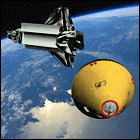 Space shuttle contractor North American Rockwell submits a safety study to NASA concerning safety and escape systems for the upcoming space shuttle, including a study of smaller vehicles with potential use as “lifeboats” in the event that a shuttle is unfit for return to Earth due to heat shield or other catastrophic damage. The various proposals, which include the possibility of permanently berthing an Apollo command module (another vehicle contracted to North American Rockwell) in the shuttle’s cargo bay for use as a lifeboat, are rejected by NASA due to the impact that each proposal would have on available space and weight for cargo.
Space shuttle contractor North American Rockwell submits a safety study to NASA concerning safety and escape systems for the upcoming space shuttle, including a study of smaller vehicles with potential use as “lifeboats” in the event that a shuttle is unfit for return to Earth due to heat shield or other catastrophic damage. The various proposals, which include the possibility of permanently berthing an Apollo command module (another vehicle contracted to North American Rockwell) in the shuttle’s cargo bay for use as a lifeboat, are rejected by NASA due to the impact that each proposal would have on available space and weight for cargo.
An international space station?
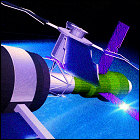 With planning already well underway for the Apollo-Soyuz mission which won’t take place until 1975, NASA commissions a study from McDonnell Douglas to explore the feasibility of a follow-up to the international space mission, possibly involving joining the backup of the Skylab space station (known as “Skylab B”) and a yet-to-be-launched Soviet Salyut space station at some point in the latter half of the 1970s, effectively creating a joint international space station. Although the study goes so far as to specify issues of concern regarding the structure of the two stations and their respective standard atmospheric pressures, the recommendations are shelved pending the outcome of the Apollo-Soyuz flight. Significant political developments in the late 1970s will prevent the idea of an international station from moving forward for at least a quarter century.
With planning already well underway for the Apollo-Soyuz mission which won’t take place until 1975, NASA commissions a study from McDonnell Douglas to explore the feasibility of a follow-up to the international space mission, possibly involving joining the backup of the Skylab space station (known as “Skylab B”) and a yet-to-be-launched Soviet Salyut space station at some point in the latter half of the 1970s, effectively creating a joint international space station. Although the study goes so far as to specify issues of concern regarding the structure of the two stations and their respective standard atmospheric pressures, the recommendations are shelved pending the outcome of the Apollo-Soyuz flight. Significant political developments in the late 1970s will prevent the idea of an international station from moving forward for at least a quarter century.
Apollo-Soyuz agreement signed
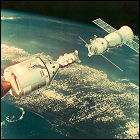 After two years of hammering out details and wording, President Nixon and Soviet Premier Alexei Kosygin sign an international agreement to share science and technology between the United States and Soviet Union, including an agreement to mount a joint space mission culminating in the docking of an Apollo spacecraft and a Soyuz spacecraft in Earth orbit in 1975. Both nations’ space agencies begin crew selection and technical preparations for a joint venture that seemed impossible during the Cold War-fueled race to the moon.
After two years of hammering out details and wording, President Nixon and Soviet Premier Alexei Kosygin sign an international agreement to share science and technology between the United States and Soviet Union, including an agreement to mount a joint space mission culminating in the docking of an Apollo spacecraft and a Soyuz spacecraft in Earth orbit in 1975. Both nations’ space agencies begin crew selection and technical preparations for a joint venture that seemed impossible during the Cold War-fueled race to the moon.
Apollo 16
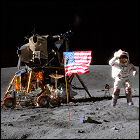 NASA launches the Apollo 16 mission to the moon, lasting 11 days total. Astronauts John Young and Charlie Duke descend to the lunar surface in the lander Orion, while Ken Mattingly pilots the command/service module Casper in orbit. Again, a lunar rover is tucked into one side of the lunar module, allowing Young and Duke to reach distances of 16 miles from their landing site. They spend a total of 20 hours walking on the moon’s surface, collecting over 200 pounds of soil and rock samples from the Descartes highlands region.
NASA launches the Apollo 16 mission to the moon, lasting 11 days total. Astronauts John Young and Charlie Duke descend to the lunar surface in the lander Orion, while Ken Mattingly pilots the command/service module Casper in orbit. Again, a lunar rover is tucked into one side of the lunar module, allowing Young and Duke to reach distances of 16 miles from their landing site. They spend a total of 20 hours walking on the moon’s surface, collecting over 200 pounds of soil and rock samples from the Descartes highlands region.
Solid rocket boosters picked for shuttle
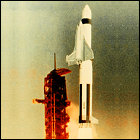 After a five-month design study focusing on alternatives to a winged (and manned) reusable first stage bosoter for the upcoming Space Shuttle, NASA settles on a configuration consisting of two solid rocket boosters strapped to the shuttle’s external fuel tank. Among the alternatives considered was the possibility of restarting production of the Saturn V rockets that launched Apollo and Skylab missions, with the shuttle and its fuel tank separating from the Saturn V’s first stage at high altitude (though in this configuration, a failure of the shuttle’s main engines would prove to be catastrophic). The SRB/tank configuration is expected to shave half a billion dollars off of the shuttle’s development costs.
After a five-month design study focusing on alternatives to a winged (and manned) reusable first stage bosoter for the upcoming Space Shuttle, NASA settles on a configuration consisting of two solid rocket boosters strapped to the shuttle’s external fuel tank. Among the alternatives considered was the possibility of restarting production of the Saturn V rockets that launched Apollo and Skylab missions, with the shuttle and its fuel tank separating from the Saturn V’s first stage at high altitude (though in this configuration, a failure of the shuttle’s main engines would prove to be catastrophic). The SRB/tank configuration is expected to shave half a billion dollars off of the shuttle’s development costs.
The Space Transportation System
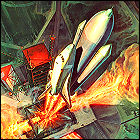 President Richard Nixon announces that, after three years of studies, design concepts, and deliberations, he has given NASA the go-ahead to develop a reusable space vehicle, the Space Shuttle, which can perform multiple mission profiles, land safely and launch again, with the eventual goal of launching a shuttle almost every week of the year. The contract to build the shuttle is awarded to Apollo command/service module contractor North American Aviation, which is later to complete a merger with Rockwell International, which assumes the task of building the shuttles. The first launch date is projected to take place at some point in the mid-to-late 1970s.
President Richard Nixon announces that, after three years of studies, design concepts, and deliberations, he has given NASA the go-ahead to develop a reusable space vehicle, the Space Shuttle, which can perform multiple mission profiles, land safely and launch again, with the eventual goal of launching a shuttle almost every week of the year. The contract to build the shuttle is awarded to Apollo command/service module contractor North American Aviation, which is later to complete a merger with Rockwell International, which assumes the task of building the shuttles. The first launch date is projected to take place at some point in the mid-to-late 1970s.
Salyut 1 down
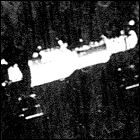 With its first crew having perished, prompting a far-reaching reorganization of the Soviet space program and its technology, the now-unmanned Salyut 1 space station is ordered to fire its thrusters, slowing it down to re-enter Earth’s atmosphere over the Pacific Ocean. With no immediate prospect of a new crew to inhabit it, the first space station intended for long-term occupation by a human crew barely lasts six months in orbit.
With its first crew having perished, prompting a far-reaching reorganization of the Soviet space program and its technology, the now-unmanned Salyut 1 space station is ordered to fire its thrusters, slowing it down to re-enter Earth’s atmosphere over the Pacific Ocean. With no immediate prospect of a new crew to inhabit it, the first space station intended for long-term occupation by a human crew barely lasts six months in orbit.
Apollo 15
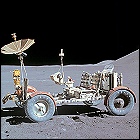 The Apollo 15 mission lifts off, carrying astronauts David Scott, James Irwin and Al Worden on a 12-day mission to the moon and back. Aboard the lunar module Falcon, Scott and Irwin become, respectively, the seventh and eighth men to walk on the moon, exploring the mountainous Hadley Rille region, while Worden pilots the command/service module Endeavour. The service module for this mission is equipped with a suite of sensors and instruments designed to be exposed to space in lunar orbit. Scott and Irwin become the first men to drive on the moon, covering over seven miles in the first lunar rover “moon buggy.”
The Apollo 15 mission lifts off, carrying astronauts David Scott, James Irwin and Al Worden on a 12-day mission to the moon and back. Aboard the lunar module Falcon, Scott and Irwin become, respectively, the seventh and eighth men to walk on the moon, exploring the mountainous Hadley Rille region, while Worden pilots the command/service module Endeavour. The service module for this mission is equipped with a suite of sensors and instruments designed to be exposed to space in lunar orbit. Scott and Irwin become the first men to drive on the moon, covering over seven miles in the first lunar rover “moon buggy.”
Soyuz 11: all hands lost
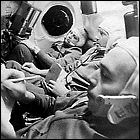 After a record-setting 22 day stay about Soviet space station Salyut 1, the crew of Soyuz 11 prepares to return home. As they undock and fire their retro rockets to bring their vehicle out of orbit, Soyuz depressurizes without warning, killing the crew – Georgi Dobrovolski, Vladislav Volkov and Viktor Patsayev – within a minute. (The cramped design of the Soyuz cabin makes no allowances for cosmonauts to wear spacesuits.) Soyuz flights will be grounded for two years until the vehicle can be redesigned to prevent another tragedy. Two members of the grounded prime crew, Alexei Leonov (the first man to walk in space) and Valery Kubasov, are later reassigned to the international Apollo-Soyuz mission in 1975.
After a record-setting 22 day stay about Soviet space station Salyut 1, the crew of Soyuz 11 prepares to return home. As they undock and fire their retro rockets to bring their vehicle out of orbit, Soyuz depressurizes without warning, killing the crew – Georgi Dobrovolski, Vladislav Volkov and Viktor Patsayev – within a minute. (The cramped design of the Soyuz cabin makes no allowances for cosmonauts to wear spacesuits.) Soyuz flights will be grounded for two years until the vehicle can be redesigned to prevent another tragedy. Two members of the grounded prime crew, Alexei Leonov (the first man to walk in space) and Valery Kubasov, are later reassigned to the international Apollo-Soyuz mission in 1975.
Soyuz 11
 After a tuberculosis scare forces Soviet space officials to ground the mission’s original crew, the backup crew of Soyuz 11 lifts off to become the first occupants of a manned space station. Experiencing none of the difficulties that plagued the earlier Soyuz 10 attempt to dock with Salyut 1, the Soyuz 11 crew stays aboard Salyut for 22 days, a new record for a manned space mission.
After a tuberculosis scare forces Soviet space officials to ground the mission’s original crew, the backup crew of Soyuz 11 lifts off to become the first occupants of a manned space station. Experiencing none of the difficulties that plagued the earlier Soyuz 10 attempt to dock with Salyut 1, the Soyuz 11 crew stays aboard Salyut for 22 days, a new record for a manned space mission.
Soyuz 10: technical difficulties
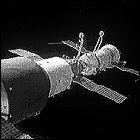 The Soviet Union launches the Soyuz 10 mission, intended to become the first crew to occupy an Earth-orbiting space station. Flying a new modification of the Soyuz vehicle, fitted with a new system for docking to the Salyut 1 space station, are Vladimir Shatalov, Alexei Yeliseyev and Nikolai Rukavishnikov, but they won’t be the first space station crew in history: the Soyuz capsule fails to hard-dock to the station, making it impossible for them to enter. Soyuz 10 returns to Earth after two days, and even on the return journey the cosmonauts are sickened by toxic fumes in their environmental system. Salyut 1 remains in orbit, still unmanned.
The Soviet Union launches the Soyuz 10 mission, intended to become the first crew to occupy an Earth-orbiting space station. Flying a new modification of the Soyuz vehicle, fitted with a new system for docking to the Salyut 1 space station, are Vladimir Shatalov, Alexei Yeliseyev and Nikolai Rukavishnikov, but they won’t be the first space station crew in history: the Soyuz capsule fails to hard-dock to the station, making it impossible for them to enter. Soyuz 10 returns to Earth after two days, and even on the return journey the cosmonauts are sickened by toxic fumes in their environmental system. Salyut 1 remains in orbit, still unmanned.
Salyut 1: the first space station
 Salyut 1, the first orbiting space station in history is launched, unmanned, by the Soviet Union. With Salyut 1, the Soviet space program intends to vault ahead of the United States in a new space discipline (namely long stays in space and the study of human endurance in a zero-G environment), having lost the moon race. The first Salyut station will orbit Earth for less than a year.
Salyut 1, the first orbiting space station in history is launched, unmanned, by the Soviet Union. With Salyut 1, the Soviet space program intends to vault ahead of the United States in a new space discipline (namely long stays in space and the study of human endurance in a zero-G environment), having lost the moon race. The first Salyut station will orbit Earth for less than a year.
Shuttle thermal protection system chosen
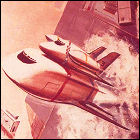 Potential contractors for NASA’s upcoming Space Shuttle offer specs based on their final design studies, which still assume that the shuttle’s giant booster will be a manned, winged vehicle in its own right that will return to a runway on Earth after its fuel is used up. One thing that both studies suggest, however, is an aluminum airframe which requires a shift away from the ablative metallic heat shields of the Mercury, Gemini and Apollo programs. A system of carbon-reinforced “shingles” is suggested as an alternative, and is approved by NASA, though developing the technology to create, install and maintain these tiles delays the first Shuttle launch into the 1980s, and the tiles are still prone to damage during both launch and re-entry – a weakness that will eventually seal the end of the Space Shuttle era.
Potential contractors for NASA’s upcoming Space Shuttle offer specs based on their final design studies, which still assume that the shuttle’s giant booster will be a manned, winged vehicle in its own right that will return to a runway on Earth after its fuel is used up. One thing that both studies suggest, however, is an aluminum airframe which requires a shift away from the ablative metallic heat shields of the Mercury, Gemini and Apollo programs. A system of carbon-reinforced “shingles” is suggested as an alternative, and is approved by NASA, though developing the technology to create, install and maintain these tiles delays the first Shuttle launch into the 1980s, and the tiles are still prone to damage during both launch and re-entry – a weakness that will eventually seal the end of the Space Shuttle era.
Apollo 14: back in business
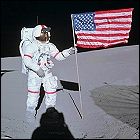 After nearly a year of examining the problems that nearly doomed the crew of Apollo 13, the third lunar landing is achieved by the crew of Apollo 14, commanded by Alan Shepard, the only one of the seven original Mercury astronauts to walk on the moon; lunar module pilot Edgar Mitchell joins him on the surface while Stu Roosa orbits in the command module Kitty Hawk. The Apollo 14 lunar module, Antares, makes the most accurate landing of the Apollo program in the Fra Mauro highlands (the landing site originally assigned to Apollo 13), where soil samples are collected, instruments are deployed, and Shepard becomes the first human being to hit a golf ball on the moon.
After nearly a year of examining the problems that nearly doomed the crew of Apollo 13, the third lunar landing is achieved by the crew of Apollo 14, commanded by Alan Shepard, the only one of the seven original Mercury astronauts to walk on the moon; lunar module pilot Edgar Mitchell joins him on the surface while Stu Roosa orbits in the command module Kitty Hawk. The Apollo 14 lunar module, Antares, makes the most accurate landing of the Apollo program in the Fra Mauro highlands (the landing site originally assigned to Apollo 13), where soil samples are collected, instruments are deployed, and Shepard becomes the first human being to hit a golf ball on the moon.
Apollo 18 & 19 cancelled
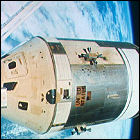 After the Congressional budget for the fiscal year of 1971 delivers a major blow to the budget for continued space exploration, NASA cancels Apollo 18 and 19, having already taken Apollo 20 off the schedule to use its Saturn V to launch a space station into Earth orbit. Both lunar landing missions are scrapped purely due to budgetary concerns, rather than to repurpose their hardware for other missions. The Saturn V rockets constructed to send these two missions to the moon become very large, expensive museum pieces. Barring any changes to crew rosters or destination, Apollo 18 would have taken Dick Gordon, Vance Brand and Harrison Schmitt to Copernicus crater, while Apollo 19 would have seen astronauts Fred Haise, William Pogue and Gerald Carr exploring the Hadley Rille, which became Apollo 15’s destination.
After the Congressional budget for the fiscal year of 1971 delivers a major blow to the budget for continued space exploration, NASA cancels Apollo 18 and 19, having already taken Apollo 20 off the schedule to use its Saturn V to launch a space station into Earth orbit. Both lunar landing missions are scrapped purely due to budgetary concerns, rather than to repurpose their hardware for other missions. The Saturn V rockets constructed to send these two missions to the moon become very large, expensive museum pieces. Barring any changes to crew rosters or destination, Apollo 18 would have taken Dick Gordon, Vance Brand and Harrison Schmitt to Copernicus crater, while Apollo 19 would have seen astronauts Fred Haise, William Pogue and Gerald Carr exploring the Hadley Rille, which became Apollo 15’s destination.
Soyuz 9: two and a half weeks in space
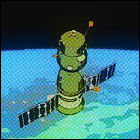 The Soviet Union launches Soyuz 9, a long-endurance mission which becomes the longest space flight in human history to date, lasting 18 days. Biomedical measurements are taken of cosmonauts Andrian Nikolayev and Vitaly Sevastyanov throughout their two-and-a-half-week stay in orbit, and Soyuz 9 is seen as a trailblazer for the Soviet space program’s new focus of long-term crewed space stations. Both cosmonauts suffer from muscle loss during their flight, as the Soyuz capsule isn’t big enough to allow for exercise.
The Soviet Union launches Soyuz 9, a long-endurance mission which becomes the longest space flight in human history to date, lasting 18 days. Biomedical measurements are taken of cosmonauts Andrian Nikolayev and Vitaly Sevastyanov throughout their two-and-a-half-week stay in orbit, and Soyuz 9 is seen as a trailblazer for the Soviet space program’s new focus of long-term crewed space stations. Both cosmonauts suffer from muscle loss during their flight, as the Soyuz capsule isn’t big enough to allow for exercise.
Apollo 13 returns home
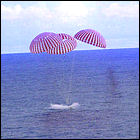 Having become the stuff of round-the-clock news coverage (though few media outlets bothered to cover any aspects of the mission before the emergency took place), the reactivated Apollo 13 command module Odyssey successfully reenters Earth’s atmosphere and returns its crew safely. (The lunar module, Aquarius, has been discarded in Earth orbit, where it eventually disintegrates, upon reentry; rather than landing on the moon, its fuel and air reserves have served the much more important function of keeping the crew alive.)
Having become the stuff of round-the-clock news coverage (though few media outlets bothered to cover any aspects of the mission before the emergency took place), the reactivated Apollo 13 command module Odyssey successfully reenters Earth’s atmosphere and returns its crew safely. (The lunar module, Aquarius, has been discarded in Earth orbit, where it eventually disintegrates, upon reentry; rather than landing on the moon, its fuel and air reserves have served the much more important function of keeping the crew alive.)
This mission is dramatized in both the We Interrupt This Mission episode of HBO’s 1998 series From The Earth To The Moon, as well as the 1995 movie Apollo 13.
Apollo 13: “Houston, we’ve had a problem”
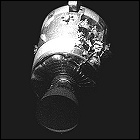 Halfway between Earth and the moon, a fuel cell rupture in the Apollo 13 service module causes a massive explosion. The crew has to activate the landing module, Aquarius, to use it as a “lifeboat”; the oxygen and power reserves of the command module, Odyssey, have been compromised by the explosion and must be preserved for re-entry. The crew endures extreme cold and must ration consumables to survive. Fortunately, there’s enough fuel in Aquarius’ descent stage to put the combined vehicle on a free-return trajectory, looping it around the far side of the moon for an immediate return to Earth.
Halfway between Earth and the moon, a fuel cell rupture in the Apollo 13 service module causes a massive explosion. The crew has to activate the landing module, Aquarius, to use it as a “lifeboat”; the oxygen and power reserves of the command module, Odyssey, have been compromised by the explosion and must be preserved for re-entry. The crew endures extreme cold and must ration consumables to survive. Fortunately, there’s enough fuel in Aquarius’ descent stage to put the combined vehicle on a free-return trajectory, looping it around the far side of the moon for an immediate return to Earth.
This mission is dramatized in both the We Interrupt This Mission episode of HBO’s 1998 series From The Earth To The Moon, as well as the 1995 movie Apollo 13.
Apollo 13
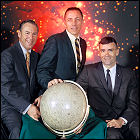 The third planned lunar landing mission, Apollo 13, lifts off. Astronauts Jim Lovell and Fred Haise are scheduled to walk in the Fra Mauro region of the moon. Command module pilot Ken Mattingly falls victim to a medical condition, leaving NASA to make a rare substitution, rotating the backup crew’s command module pilot, Jack Swigert, to the prime crew prior to launch.
The third planned lunar landing mission, Apollo 13, lifts off. Astronauts Jim Lovell and Fred Haise are scheduled to walk in the Fra Mauro region of the moon. Command module pilot Ken Mattingly falls victim to a medical condition, leaving NASA to make a rare substitution, rotating the backup crew’s command module pilot, Jack Swigert, to the prime crew prior to launch.
This mission is dramatized in both the We Interrupt This Mission episode of HBO’s 1998 series From The Earth To The Moon, as well as the 1995 movie Apollo 13.
Hear about it on the Sci-Fi 5 podcast
Apollo 20 hardware reassigned to Skylab
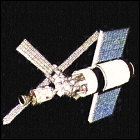 NASA formally cancels the planned Apollo 20 mission to the moon’s Copernicus crater in order to begin converting the upper stage of the mission’s Saturn V rocket into the Skylab space station, to be launched in the early 1970s. Construction of the Apollo command/service module and lunar module scheduled to fly this mission was halted before either vehicle was completed. The crew would have consisted of Stu Roosa, Paul Weitz and Jack Lousma; ironically, Weitz was transferred to the first Skylab crew, while Lousma was part of the second Skylab crew. Both later flew on shuttle missions.
NASA formally cancels the planned Apollo 20 mission to the moon’s Copernicus crater in order to begin converting the upper stage of the mission’s Saturn V rocket into the Skylab space station, to be launched in the early 1970s. Construction of the Apollo command/service module and lunar module scheduled to fly this mission was halted before either vehicle was completed. The crew would have consisted of Stu Roosa, Paul Weitz and Jack Lousma; ironically, Weitz was transferred to the first Skylab crew, while Lousma was part of the second Skylab crew. Both later flew on shuttle missions.
Apollo 12: more footprints on the moon
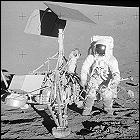 Astronauts Pete Conrad and Alan Bean land on the moon in the Apollo 12 lunar module Intrepid, a mere 600 feet away from the 1967 landing site of the unmanned Surveyor 3 probe. Pieces of Surveyor 3 are gathered for return to Earth to study the effects of prolonged exposure to the lunar environment. Conrad and Bean conduct two moonwalks, each lasting nearly four hours.
Astronauts Pete Conrad and Alan Bean land on the moon in the Apollo 12 lunar module Intrepid, a mere 600 feet away from the 1967 landing site of the unmanned Surveyor 3 probe. Pieces of Surveyor 3 are gathered for return to Earth to study the effects of prolonged exposure to the lunar environment. Conrad and Bean conduct two moonwalks, each lasting nearly four hours.
Apollo 12
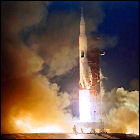 Apollo 12 lifts off, with astronauts Pete Conrad and Alan Bean set to become the next pair of human moonwalkers aboard the lunar module Intrepid, while Dick Gordon observes from orbit in the command/service module Yankee Clipper. The Intrepid crew is also assigned to deploy an instrument package called ALSEP (Apollo Lunar Scientific Experiment Package) which will be left on the surface even after their departure. The mission lasts ten days.
Apollo 12 lifts off, with astronauts Pete Conrad and Alan Bean set to become the next pair of human moonwalkers aboard the lunar module Intrepid, while Dick Gordon observes from orbit in the command/service module Yankee Clipper. The Intrepid crew is also assigned to deploy an instrument package called ALSEP (Apollo Lunar Scientific Experiment Package) which will be left on the surface even after their departure. The mission lasts ten days.
Soyuz 8
 The Soviet Union launches Soyuz 8, intended to be the passive partner in a space rendezvous and docking with Soyuz 7 (launched the previous day), as the already-launched Soyuz 6 films the docking. When the rendezvous radar gear aboard all three Soyuz vehicles fail to function properly, the docking is aborted; the only history made by the near-simultaneous trio of Soyuz craft is the largest number of humans in orbit at the same time to date (seven). Cosmonauts Vladimir Shatalov and Alexei Yeliseyev – both veterans of the docking missions of Soyuz 4 and 5 earlier in the year – return to Earth after nearly five days in space.
The Soviet Union launches Soyuz 8, intended to be the passive partner in a space rendezvous and docking with Soyuz 7 (launched the previous day), as the already-launched Soyuz 6 films the docking. When the rendezvous radar gear aboard all three Soyuz vehicles fail to function properly, the docking is aborted; the only history made by the near-simultaneous trio of Soyuz craft is the largest number of humans in orbit at the same time to date (seven). Cosmonauts Vladimir Shatalov and Alexei Yeliseyev – both veterans of the docking missions of Soyuz 4 and 5 earlier in the year – return to Earth after nearly five days in space.
Soyuz 7
 The Soviet Union launches Soyuz 7, intended to be the active partner in a space rendezvous and docking with Soyuz 8 (launched the following day), as the already-launched Soyuz 6 films the docking. When the rendezvous radar gear aboard all three Soyuz vehicles fail to function properly, the docking is aborted. Cosmonauts Anatoly Filipchenko, Vladislav Volkov and Viktor Gorbatko return to Earth after nearly five days in space.
The Soviet Union launches Soyuz 7, intended to be the active partner in a space rendezvous and docking with Soyuz 8 (launched the following day), as the already-launched Soyuz 6 films the docking. When the rendezvous radar gear aboard all three Soyuz vehicles fail to function properly, the docking is aborted. Cosmonauts Anatoly Filipchenko, Vladislav Volkov and Viktor Gorbatko return to Earth after nearly five days in space.
Soyuz 6
 The Soviet Union launches the first Soyuz mission since the American moon landing, Soyuz 6. With Georgi Shonin and future Apollo-Soyuz crewmember Valery Kubasov aboard, Soyuz 6 is intended to “chase’ two other manned Soyuz capsules launched in the days ahead, filming them as they perform an orbital docking maneuver. When the rendezvous radar gear aboard all three Soyuz vehicles fail to function properly, the docking is aborted. Shonin and Kubasov return to Earth after nearly five days in space.
The Soviet Union launches the first Soyuz mission since the American moon landing, Soyuz 6. With Georgi Shonin and future Apollo-Soyuz crewmember Valery Kubasov aboard, Soyuz 6 is intended to “chase’ two other manned Soyuz capsules launched in the days ahead, filming them as they perform an orbital docking maneuver. When the rendezvous radar gear aboard all three Soyuz vehicles fail to function properly, the docking is aborted. Shonin and Kubasov return to Earth after nearly five days in space.
Apollo 11: first manned lunar landing
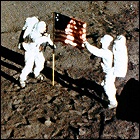 The Apollo 11 lunar module touches down in the Sea of Tranquility, a flat plain on the moon. Astronaut Neil Armstrong is the first human being to set foot on another body in the solar system, followed by “Buzz” Aldrin; the two spend roughly two and a half hours on the moon and gather nearly 50 pounds of samples of lunar soil and rock. This feat effectively ends the Cold War space race, though both the United States and the Soviet Union continue their lunar efforts: more Apollo missions are still on the schedule, and the Soviet continue trying to mount a successful launch of their giant N1 rocket.
The Apollo 11 lunar module touches down in the Sea of Tranquility, a flat plain on the moon. Astronaut Neil Armstrong is the first human being to set foot on another body in the solar system, followed by “Buzz” Aldrin; the two spend roughly two and a half hours on the moon and gather nearly 50 pounds of samples of lunar soil and rock. This feat effectively ends the Cold War space race, though both the United States and the Soviet Union continue their lunar efforts: more Apollo missions are still on the schedule, and the Soviet continue trying to mount a successful launch of their giant N1 rocket.
This mission is dramatized in the Mare Tranquilitatis episode of HBO’s 1998 series From The Earth To The Moon.
Hear about it on the Sci-Fi 5 podcast
Apollo 11
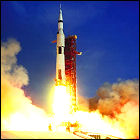 Apollo 11 lifts off, with astronauts Neil Armstrong, Buzz Aldrin and Michael Collins aboard. This is the first mission scheduled to attempt a landing on the moon, with Armstrong and Aldrin aboard the lunar module while Collins remains in orbit in the command/service module.
Apollo 11 lifts off, with astronauts Neil Armstrong, Buzz Aldrin and Michael Collins aboard. This is the first mission scheduled to attempt a landing on the moon, with Armstrong and Aldrin aboard the lunar module while Collins remains in orbit in the command/service module.
Manned Orbital Laboratory cancelled
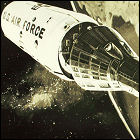 The Air Force officially cancels its plans for Manned Orbiting Laboratory, a space station in development that would have used Gemini capsules and technology to build and maintain a military outpost in space. The airmen selected as MOL crew members are transferred to NASA, where some of them will go on to fly the Space Shuttle, a vehicle whose design is still in its infancy at this point. The Air Force is also consulted on its military satellite launch needs, which are taken into account in the design of the shuttle.
The Air Force officially cancels its plans for Manned Orbiting Laboratory, a space station in development that would have used Gemini capsules and technology to build and maintain a military outpost in space. The airmen selected as MOL crew members are transferred to NASA, where some of them will go on to fly the Space Shuttle, a vehicle whose design is still in its infancy at this point. The Air Force is also consulted on its military satellite launch needs, which are taken into account in the design of the shuttle.
Apollo 10
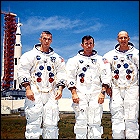 Apollo 10 lifts off for a dress rehearsal over the moon. Thomas Stafford, Gene Cernan and John Young fly a complete Apollo stack – both the command/service module and the lunar model – to the moon, conducting practice maneuvers in lunar orbit. Over eight days, the Apollo 10 crew does everything but land on the moon. With the mission requirements fulfilled, NASA announces that the next Apollo mission will attempt an actual landing.
Apollo 10 lifts off for a dress rehearsal over the moon. Thomas Stafford, Gene Cernan and John Young fly a complete Apollo stack – both the command/service module and the lunar model – to the moon, conducting practice maneuvers in lunar orbit. Over eight days, the Apollo 10 crew does everything but land on the moon. With the mission requirements fulfilled, NASA announces that the next Apollo mission will attempt an actual landing.
This mission is dramatized in the Spider episode of HBO’s 1998 series From The Earth To The Moon.
NASA solicits shuttle, station proposals
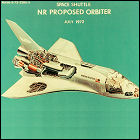 NASA formally asks various major players in the aerospace industry for proposals for what the agency sees as its two major projects for the 1970s: an orbiting space station and a reusable Space Shuttle to make routine flights from Earth to the station – which NASA hopes will be a “50 man space base” – and back again, with supplies, experiments, and new crew members. (Within mere weeks, the hypothetical station’s equally hypothetical crew will be downsized to a dozen.) In the event that the development curve on the Space Shuttle proves to be a long one, NASA says it will keep Apollo and even Gemini spacecraft in service to make flights to the station.
NASA formally asks various major players in the aerospace industry for proposals for what the agency sees as its two major projects for the 1970s: an orbiting space station and a reusable Space Shuttle to make routine flights from Earth to the station – which NASA hopes will be a “50 man space base” – and back again, with supplies, experiments, and new crew members. (Within mere weeks, the hypothetical station’s equally hypothetical crew will be downsized to a dozen.) In the event that the development curve on the Space Shuttle proves to be a long one, NASA says it will keep Apollo and even Gemini spacecraft in service to make flights to the station.